Scientific Papers in SCI
2019
2019
Materiales de Diseño para la Energía y Medioambiente
Bionanocomposites based on chitosan intercalation in designed swelling high-charged micas
Alba, MD; Cota, A; Osuna, FJ; Pavon, E; Perdigon, AC; Raffin, FScientific Reports, 9 (2019) art. 10265
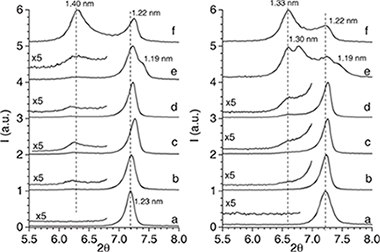
Bionanocomposites based on layered inorganic components, as clays, and polymers of biological origin, as chitosan, have a major impact in medical and environmental fields, being economical and environmentally friendly materials. Na-Mn micas (n = 2 and 4) with controlled surface charge, high cation exchange capacity and swelling behaviour, are attractive inorganic composite components that exhibit improved adsorption properties compared to other inorganic solids which makes them potentially useful for bionanocomposites. The goal of this research was to explore the potential use of those synthetic brittle micas to form eco-friendly bionanocomposites with chitosan biopolymer. Hence, chitosan-mica bionanocomposites were prepared by ion-exchange reaction between chitosan solution and synthetic high charge mica. X-ray diffraction, Fourier transform infrared spectroscopy, thermal analysis, MAS-NMR spectroscopy and zeta-potential have been employed for bionanocomposites characterization. The results showed that the adsorption of chitosan is effective, although a chitosan portion remains in the outer surface being hydrogen-bonded to the tetrahedral sheet of the silicate.
July, 2019 | DOI: 10.1038/s41598-019-46495-z
Nanotecnología en Superficies y Plasma
On‐Surface Synthesis and Characterization of Acene‐Based Nanoribbons Incorporating Four‐Membered Rings
Sanchez-Sanchez, C; Dienel, T; Nicolai, A; Kharche, N; Liang, LB; Daniels, C; Meunier, V; Liu, JZ; Feng, XL; Mullen, K; Sanchez-Valencia, JR; Groning, O; Ruffieux, P; Fasel, RChemistry-A European Journal
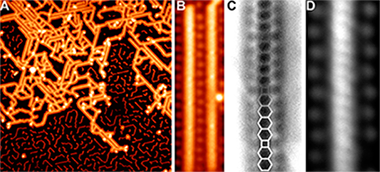
A bottom up method for the synthesis of unique tetracene-based nanoribbons, which incorporate cyclobutadiene moieties as linkers between the acene segments, is reported. These structures were achieved through the formal [2+2] cycloaddition reaction of ortho-functionalized tetracene precursor monomers. The formation mechanism and the electronic and magnetic properties of these nanoribbons were comprehensively studied by means of a multitechnique approach. Ultra-high vacuum scanning tunneling microscopy showed the occurrence of metal-coordinated nanostructures at room temperature and their evolution into nanoribbons through formal [2+2] cycloaddition at 475 K. Frequency-shift non-contact atomic force microscopy images clearly proved the presence of bridging cyclobutadiene moieties upon covalent coupling of activated tetracene molecules. Insight into the electronic and vibrational properties of the so-formed ribbons was obtained by scanning tunneling microscopy, Raman spectroscopy, and theoretical calculations. Magnetic properties were addressed from a computational point of view, allowing us to propose promising candidates to magnetic acene-based ribbons incorporating four-membered rings. The reported findings will increase the understanding and availability of new graphene-based nanoribbons with high potential in future spintronics.
July, 2019 | DOI: 10.1002/chem.201901410
Química de Superficies y Catálisis
Size-tailored Ru nanoparticles deposited over gamma-Al2O3 for the CO2 methanation reaction
Navarro-Jaen, S; Navarro, JC; Bobadilla, LF; Centeno, MA; Laguna, OH; Odriozola, JAApplied Surface Science, 483 (2019) 750-761

By means of the polyol method, a series of 5 wt% Ru/Al2O3 catalysts was synthesized controlling the particle size of the ruthenium species. The physico-chemical characterization demonstrated the successful particle size control of the Ru species, in such a way that higher the Ru/PVP ratio, higher the Ru particle size. Moreover, there are evidences that suggest preferential growth of the RuO2 clusters depending on the Ru/PVP ratio. Regarding the catalytic activity during the CO2 methanation, the total conversion and the CH4 yield increased with the particle size of Ru. Nevertheless, a considerable enhancement of the catalytic performance of the most active system was evidenced at 4 bar, demonstrating the improvement of the thermodynamics (superior total conversion) and kinetics (superior reaction rate) of the CO2 methanation at pressures above the atmospheric one. Finally, the in situ DRIFTS study allowed to establish that CO2 was dissociated to CO* and O* species on the metallic Ru particles, followed by the consecutive hydrogenation of CO* towards CHO*, CH2O*, CH3O*, and finally CH4 molecules, which were further desorbed from the catalyst. Thus from the mechanistic point of view, a suitable particle size of the Ru nanoparticles along with the high-pressure effects results in the enhancement of the availability of hydrogen and consequently in the formation of CHxO species that enhance the cleavage of the C-O bond, which is the rate-determining step of the overall CO2 methanation process.
July, 2019 | DOI: 10.1016/j.apsusc.2019.03.248
Química de Superficies y Catálisis - Reactividad de Sólidos
Influence of the preparation method in the metal-support interaction and reducibility of Ni-Mg-Al based catalysts for methane steam reforming
Azancot, L; Bobadilla, LF; Santos, JL; Cordoba, JM; Centeno, MA; Odriozola, JAInternational Journal of Hydrogen Energy, 44 (2019) 19827-19840
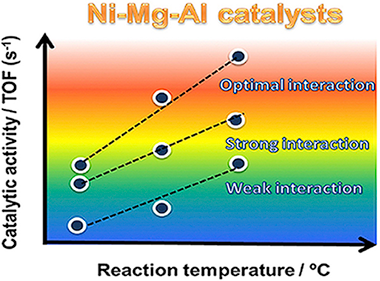
Ni-Mg-Al based catalysts were prepared using different preparation methods (impregnation, impregnation-coprecipitation and coprecipitation) and tested in steam reforming of methane. The differences observed in catalytic activity were directly correlated to the physicochemical properties and the different degree of Ni-Mg-Al interaction. The reducibility results showed that the catalyst prepared by the impregnation-coprecipitation method presented the most optimal metal-support interaction to reduce the NiO preserving the Ni-0 particles highly dispersed on the support surface. These results demonstrate that the structure and catalytic performance of Ni-Mg-Al based catalysts can be tuned by controlling the metal-support interaction through of the preparation method.
July, 2019 | DOI: 10.1016/j.ijhydene.2019.05.167
Laboratory multi-technique study of Spanish decorated leather from the 12th to 14th centuries
Franquelo, ML; Duran, A; Perez-Rodriguez, JLSpectrochimica Acta Part A: Molecular and Biomolecular Spectroscopy, 218 (2019) 331-341
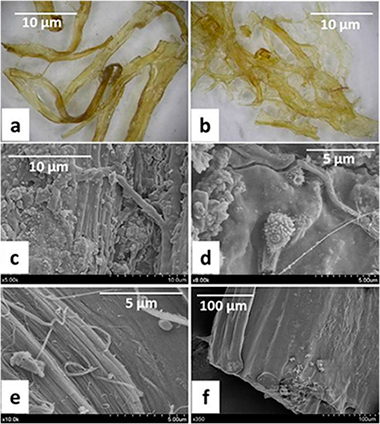
This work comprises an exhaustive study of Spanish decorative leathers dating from the 12th to 14th centuries. These paintings are considered a key example of a crucible of artistic styles: Gothic, Islamic and Florentine Trecento. The goal of this work was to use the scientific information provided by a number of experimental techniques – namely EDX, micro-FTIR, micro-Raman and micro-XRD – to assess the dating of the wooden vault, leather preparation and filling fibres. Another goal was to assess the artistic technique based on the characterization of pigments and the differentiation between original materials and those added throughout its history. Gypsum was the original preparation layer extended over the leather. A new preparation stratum was added in further interventions with the artwork. The original pictorial materials and those used during refurbishments have been identified. Original pigments were: red lead, Mars red, red lake, cinnabar, lapis lazuli, red ochres, raw sienna, white lead and charcoal black. Gilding was also found. Pigments added during restoration were: barite, emerald green, rutile, anatase, Mars red, cadmium red, lithopone, cadmium yellow, charcoal black and orpiment.
July, 2019 | DOI: 10.1016/j.saa.2019.04.012
Nanotecnología en Superficies y Plasma
Plasma Enabled Conformal and Damage Free Encapsulation of Fragile Molecular Matter: from Surface-Supported to On-Device Nanostructures
Alcaire, M; Aparicio, FJ; Obrero, J; Lopez-Santos, C; Garcia-Garcia, FJ; Sanchez-Valencia, JR; Frutos, F; Ostrikov, K; Borras, A; Barranco, AAdvanced Functional Materials, (2019) art. 1903535

Damage-free encapsulation of molecular structures with functional nanolayers is crucial to protect nanodevices from environmental exposure. With nanoscale electronic, optoelectronic, photonic, sensing, and other nanodevices based on atomically thin and fragile organic matter shrinking in size, it becomes increasingly challenging to develop nanoencapsulation that is simultaneously conformal at atomic scale and does not damage fragile molecular networks, while delivering added device functionality. This work presents an effective, plasma-enabled, potentially universal approach to produce highly conformal multifunctional organic films to encapsulate atomically thin graphene layers and metalorganic nanowires, without affecting their molecular structure and atomic bonding. Deposition of adamantane precursor and gentle remote plasma chemical vapor deposition are synergized to assemble molecular fragments and cage-like building blocks and completely encapsulate not only the molecular structures, but also the growth substrates and device elements upon nanowire integration. The films are insulating, transparent, and conformal at sub-nanometer scale even on near-tip high-curvature areas of high-aspect-ratio nanowires. The encapsulated structures are multifunctional and provide effective electric isolation, chemical and environmental protection, and transparency in the near-UV-visible-near-infrared range. This single-step, solvent-free remote-plasma approach preserves and guides molecular building blocks thus opening new avenues for precise, atomically conformal nanofabrication of fragile nanoscale matter with multiple functionalities.
July, 2019 | DOI: 10.1002/adfm.201903535
Química de Superficies y Catálisis
Au/CeO2-ZnO/Al2O3 as Versatile Catalysts for Oxidation Reactions: Application in Gas/Liquid Environmental Processes
Megias-Sayago, C; Reina, TR; Ivanova, S; Odriozola, JAFrontiers in Chemistry, 7 (2019) art. 504

The present work showcases the versatility of nanogold systems supported on Zn-doped ceria when applied in two important environmental processes, the total CO oxidation, and the liquid phase oxidation of glucose to gluconic acid. In the CO oxidation the suitability of these materials is clearly demonstrated achieving full conversions even at sub-ambient conditions. Regarding the glucose oxidation our materials display high conversion values (always over 50%) and very importantly full or almost full selectivity toward gluconic acid-an added value platform chemical in the context of biomass upgrading routes. The key factors controlling the successful performance on both reactions are carefully discussed and compared to previous studies in literature. To our knowledge this is one of the very few works in catalysis by gold combining liquid and gas phase reactions and represents a step forward in the flexible behavior of nano gold catalysts.
July, 2019 | DOI: 10.3389/fchem.2019.00504
Nanotecnología en Superficies y Plasma
2D compositional self-patterning in magnetron sputtered thin films
Garcia-Valenzuela, A; Alvarez, R; Rico, V; Espinos, JP; Lopez-Santos, MC; Solis, J; Siegel, J; del Campo, A; Palmero, A; Gonzalez-Elipe, ARApplied Surface Science, 480 (2019) 115-121
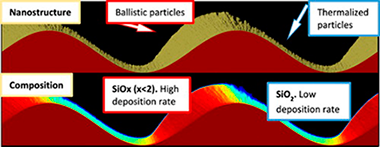
Unlike topography patterning, widely used for numerous applications and produced by means of different technologies, there are no simple procedures to achieve surface compositional patterning at nanometric scales. In this work we have developed a simple method for 2D patterning the composition of thin films. The method relies on the magnetron sputtering deposition at oblique angles onto patterned substrates made by laser induced periodic surface structures (LIPSS). The method feasibility has been demonstrated by depositing SiOx thin films onto LIPSS structures generated in Cr layers. A heterogeneous and aligned distribution of O/Si ratios (and different Sin+ chemical states) along the LIPSS structure in length scales of some hundreds nm's has been proven by angle resolved X-ray photoelectron spectroscopy and a patterned arrangement of composition monitored by atomic force microscopy-Raman analysis. The obtained results are explained by the predictions of a Monte Carlo simulation of this deposition process and open the way for the tailored one-step fabrication of surface devices with patterned compositions.
June, 2019 | DOI: 10.1016/j.apsusc.2019.02.206
Materiales y Procesos Catalíticos de Interés Ambiental y Energético
Comprehensive Experimental and Theoretical Study of the CO plus NO Reaction Catalyzed by Au/Ni Nanoparticles
Kyriakou, G; Marquez, AM; Holgado, JP; Taylor, MJ; Wheatley, AEH; Mehta, JP; Sanz, JF; Beaumont, SK; Lambert, RMACS Catalysis, 9 (2019) 4919-4929
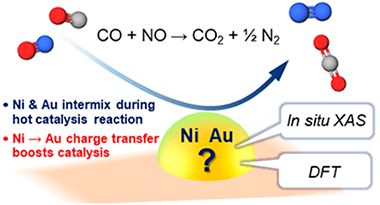
The catalytic and structural properties of five different nanoparticle catalysts with varying Au/Ni composition were studied by six different methods, including in situ X-ray absorption spectroscopy and density functional theory (DFT) calculations. The as-prepared materials contained substantial amounts of residual capping agent arising from the commonly used synthetic procedure. Thorough removal of this material by oxidation was essential for the acquisition of valid catalytic data. All catalysts were highly selective toward N-2 formation, with 50-50 Au:Ni material being best of all. In situ X-ray absorption near edge structure spectroscopy showed that although Au acted to moderate the oxidation state of Ni, there was no clear correlation between catalytic activity and nickel oxidation state. However, in situ extended X-ray absorption fine structure spectroscopy showed a good correlation between Au Ni coordination number (highest for Ni50Au50) and catalytic activity. Importantly, these measurements also demonstrated substantial and reversible Au/Ni intermixing as a function of temperature between 550 degrees C (reaction temperature) and 150 degrees C, underlining the importance of in situ methods to the correct interpretation of reaction data. DFT calculations on smooth, stepped, monometallic and bimetallic surfaces showed that N + N recombination rather than NO dissociation was always rate-determining and that the activation barrier to recombination reaction decreased with increased Au content, thus accounting for the experimental observations. Across the entire composition range, the oxidation state of Ni did not correlate with activity, in disagreement with earlier work, and theory showed that NiO itself should be catalytically inert. Au-Ni interactions were of paramount importance in promoting N + N recombination, the rate-limiting step.
June, 2019 | DOI: 10.1021/acscatal.8b05154
Materiales Nanoestructurados y Microestructura
Exchange bias and two steps magnetization reversal in porous Co/CoO layer
Ovejero, JG; Godinho, V; Lacroix, B; Garcia, MA; Hernando, A; Fernandez, AMaterials & Design, 171 (2019) 107691
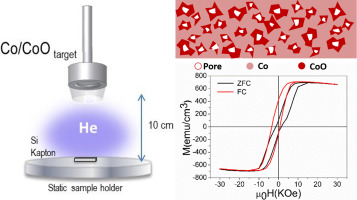
In this paper Co/CoO thick layers (hundreds of nanometers) of different porosity and oxidation degree were prepared in a magnetron sputtering deposition processby tailoring the DC sputtering power, as well as the process gas and target composition. The control of the synthesis parameters allowed the nanostructuration of the films with a singular distribution of closed pores and a controlled amount of CoO. We observed an exchange bias field of 2.8 KOe for porous Co/CoO composites, similar to Co/CoO bilayers but for coatings thicker than 300 nm. Besides, it was observed that the coating presents bistable magnetic features when cooled under zero field conditions as a result of the unusual exchange coupling.
June, 2019 | DOI: 10.1016/j.matdes.2019.107691
- ‹ previous
- 70 of 214
- next ›














